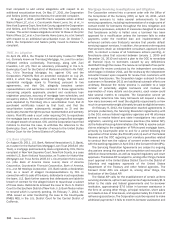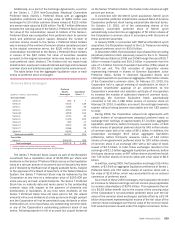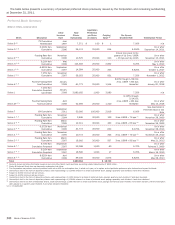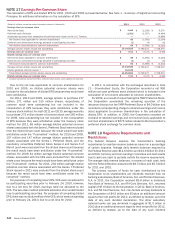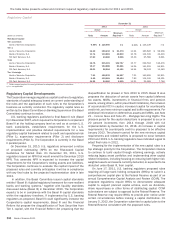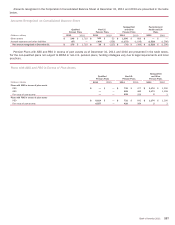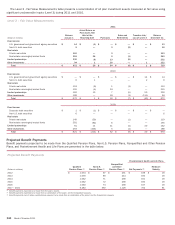Bank of America 2011 Annual Report Download - page 235
Download and view the complete annual report
Please find page 235 of the 2011 Bank of America annual report below. You can navigate through the pages in the report by either clicking on the pages listed below, or by using the keyword search tool below to find specific information within the annual report.Bank of America 2011 233
declaration. The amount of dividends that each subsidiary bank
may declare in a calendar year without approval by the OCC is the
subsidiary bank’s net profits for that year combined with its net
retained profits, as defined, for the preceding two years.
The Federal Reserve, OCC and FDIC (collectively, joint agencies)
have in place regulatory capital guidelines for U.S. banking
organizations. Failure to meet the capital requirements can initiate
certain mandatory and discretionary actions by regulators that
could have a material effect on the Corporation’s financial position.
The regulatory capital guidelines measure capital in relation to the
credit and market risks of both on- and off-balance sheet items
using various risk weights. Under the regulatory capital guidelines,
Total capital consists of three tiers of capital. Tier 1 capital includes
qualifying common shareholders’ equity, qualifying noncumulative
perpetual preferred stock, qualifying Trust Securities, hybrid
securities and qualifying non-controlling interests, less goodwill
and other adjustments. Tier 2 capital consists of qualifying
subordinated debt, a limited portion of the allowance for loan and
lease losses, a portion of net unrealized gains on AFS marketable
equity securities and other adjustments. Tier 3 capital includes
subordinated debt that is unsecured, fully paid, has an original
maturity of at least two years, is not redeemable before maturity
without prior approval by the Federal Reserve and includes a lock-
in clause precluding payment of either interest or principal if the
payment would cause the issuing bank’s risk-based capital ratio
to fall or remain below the required minimum. Tier 3 capital can
only be used to satisfy the Corporation’s market risk capital
requirement and may not be used to support its credit risk
requirement. At December 31, 2011 and 2010, the Corporation
had no subordinated debt that qualified as Tier 3 capital.
Certain corporate-sponsored trust companies which issue
Trust Securities are not consolidated. In accordance with Federal
Reserve guidance, Trust Securities continue to qualify as Tier 1
capital with revised quantitative limits effective March 31, 2011.
As a result, the Corporation includes Trust Securities in Tier 1
capital. The Financial Reform Act includes a provision under which
the Corporation’s previously issued and outstanding Trust
Securities in the aggregate amount of $16.1 billion (approximately
125 bps of Tier 1 capital) at December 31, 2011, will no longer
qualify as Tier 1 capital effective January 1, 2013. This amount
excludes $633 million of hybrid Trust Securities that are expected
to be converted to preferred stock prior to the date of
implementation. The exclusion of Trust Securities from Tier 1
capital will be phased in incrementally over a three-year phase-in
period. The treatment of Trust Securities during the phase-in period
remains unclear and is subject to future rulemaking.
Current limits restrict core capital elements to 15 percent of
total core capital elements for internationally active bank holding
companies. Internationally active bank holding companies are
those that have significant activities in non-U.S. markets with
consolidated assets greater than $250 billion or on-balance sheet
non-U.S. exposure greater than $10 billion. In addition, the Federal
Reserve revised the qualitative standards for capital instruments
included in regulatory capital. At December 31, 2011, the
Corporation’s restricted core capital elements comprised 9.1
percent of total core capital elements. The Corporation is and
expects to remain compliant with the revised limits.
To meet minimum, adequately capitalized regulatory
requirements, an institution must maintain a Tier 1 capital ratio
of four percent and a Total capital ratio of eight percent. A “well-
capitalized” institution must generally maintain capital ratios
200 bps higher than the minimum guidelines. The risk-based
capital rules have been further supplemented by a Tier 1 leverage
ratio, defined as Tier 1 capital divided by quarterly average total
assets, after certain adjustments. “Well-capitalized” bank holding
companies must have a minimum Tier 1 leverage ratio of four
percent. National banks must maintain a Tier 1 leverage ratio of
at least five percent to be classified as “well-capitalized.” At
December 31, 2011, the Corporation’s Tier 1 capital, Total capital
and Tier 1 leverage ratios were 12.40 percent, 16.75 percent and
7.53 percent, respectively. This classifies the Corporation as “well-
capitalized” for regulatory purposes, the highest classification.
Net unrealized gains or losses on AFS debt securities and
marketable equity securities, net unrealized gains and losses on
derivatives, and employee benefit plan adjustments in
shareholders’ equity are excluded from the calculations of Tier 1
common capital as discussed below, Tier 1 capital and leverage
ratios. The Total capital ratio excludes all of the above with the
exception of up to 45 percent of the pre-tax net unrealized gains
on AFS marketable equity securities.
The Corporation calculates Tier 1 common capital as Tier 1
capital including any CES less preferred stock, qualifying Trust
Securities, hybrid securities and qualifying noncontrolling interest
in subsidiaries. CES was included in Tier 1 common capital based
upon applicable regulatory guidance and the expectation at
December 31, 2009 that the underlying Common Equivalent Junior
Preferred Stock, Series S would convert into common stock
following shareholder approval of additional authorized shares.
Shareholders approved the increase in the number of authorized
shares of common stock and the Common Equivalent Stock
converted into common stock on February 24, 2010. Tier 1
common capital was $126.7 billion and $125.1 billion and the
Tier 1 common capital ratio was 9.86 percent and 8.60 percent
at December 31, 2011 and 2010.





